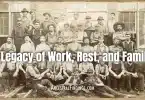The telephone was invented earlier than most people may realize. By 1900, it was already present in some private households. The adoption of the use of the telephone after its invention is interesting. The White House had the first household telephone, while the first city-wide telephone was in the frontier town of Deadwood, South Dakota. Here’s how the telephone was adopted by cities and gradually made its way into households as a regular part of daily living for most Americans.
Until the telegram was invented in the mid-1800’s, letters, which often took weeks or months to arrive at their destination, were the only way to communicate with people over long distances. It was this way for all of human history since the invention of writing up until that time. A couple of decades later, Alexander Graham Bell and other inventors were working on an improvement to the telegraph in the form of the telephone. While more than one inventor claimed to be the first to invent the telephone, Bell was the first to patent it, so he generally gets the credit for it in history.
The patent was granted in March of 1876 and became the master patent, upon which all additional patents for improvements on the telephone followed. The telephone switch was invented just a few weeks after the telephone, and the patent was granted to Tivadar Puskas, a Hungarian inventor. The telephone switch allowed telephone exchanges to be formed, which led to the invention of telephone networks.
President Rutherford B. Hayes installed the first telephone in the White House in 1879. It was the first use of a telephone in a residence. Slowly, other households, usually of wealthy people, began to get telephones and could call each other. The first households to get telephones were of people who had dealings with the President. Then, gradually, their friends and family began to get telephones. The first town to get city-wide telephone service was Deadwood, South Dakota, in March of 1878. It was on the edge of the American frontier at the time, and the town just had one phone that was made available to the whole town to use. It had a line that connected directly to the White House. Eventually, Deadwood had a telephone operator’s office and many of the homes and businesses in town had individual telephones for calling each other.
Gradually, other towns started getting telephone service, though it was usually only the big cities in the beginning. Deadwood, on the frontier, remained the exception for the first few decades of the use of the telephone. The adoption of the telephone was gradual, and many towns just had one town phone for a lot of years before getting individual household phones. Rural areas of the United States didn’t get phone service until after WWII. This was long after a trans-Atlantic cable was laid to make international phone calls possible. Within just a few decades, communication that would have taken months or more for our immigrant ancestors with their families overseas could take place in real time, and the world of communication was changed forever, leading to the mobile phone technology we enjoy all over the world today. Now, it’s a rare person who doesn’t own or have access to a telephone.






